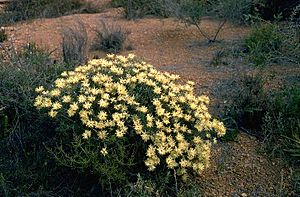Petrophile megalostegia facts for kids
Quick facts for kids Petrophile megalostegia |
|
|---|---|
 |
|
| Near Geraldton | |
| Scientific classification | |
| Genus: |
Petrophile
|
| Species: |
megalostegia
|
| Synonyms | |
|
|
The Petrophile megalostegia is a unique flowering plant found only in southwestern Western Australia. It's a type of shrub that belongs to the Proteaceae family. This plant is special because its leaves can be needle-shaped or flat, sometimes even S-shaped, and they always have a sharp tip. Its flowers are yellow to cream-colored and feel silky to the touch.
Contents
What Does Petrophile megalostegia Look Like?
This plant is an upright shrub that usually grows to be about 0.3 to 1 meter tall. Its branches and leaves are smooth, meaning they don't have any hairs. The leaves can be round like a cylinder or flat. They are typically 25 to 85 millimeters long and have a very sharp point at the end.
The flowers grow in roundish clusters at the ends of the branches. These clusters are surrounded by smooth, egg-shaped or oval leaves called involucral bracts. Each flower can be up to 30 millimeters long and is either yellow, cream, or a mix of both. They are also covered in soft, silky hairs.
This plant mainly blooms from August to October. After flowering, it produces a type of fruit called a nut. These nuts are joined together in an oval-shaped head that can be up to 15 millimeters long.
How Was Petrophile megalostegia Named?
The Petrophile megalostegia was officially described for the first time in 1876. This was done by a botanist named Ferdinand von Mueller. He wrote about it in his book, Fragmenta Phytographiae Australiae, using plant samples collected by James Drummond.
The second part of its scientific name, megalostegia, comes from Greek words. It means "large roof, tent, or house." This name refers to the large, protective leaves (involucral bracts) that surround the flower heads.
Where Does Petrophile megalostegia Grow?
This type of petrophile plant is found in a specific area of southwestern Western Australia. You can see it growing between the towns of Mullewa, Eneabba, and Watheroo.
It prefers to grow in areas with heathland and shrubland. These regions are part of what scientists call the Avon Wheatbelt, Geraldton Sandplains, and Swan Coastal Plain biogeographic regions.
Is Petrophile megalostegia Protected?
The good news is that the Western Australian Government's Department of Parks and Wildlife has classified Petrophile megalostegia as "not threatened." This means it is not currently at risk of disappearing.

